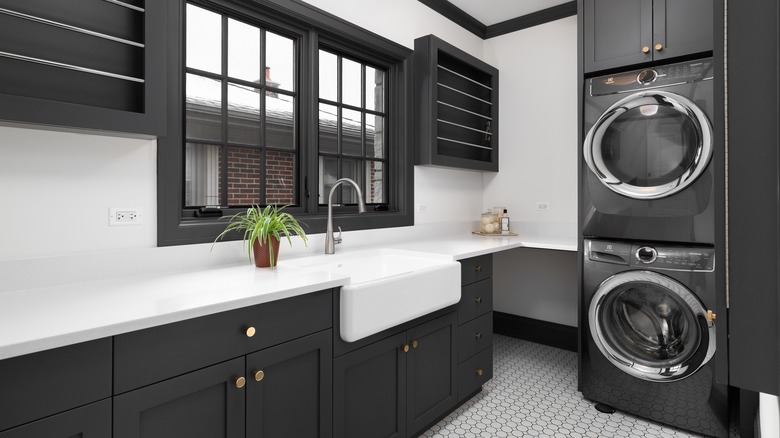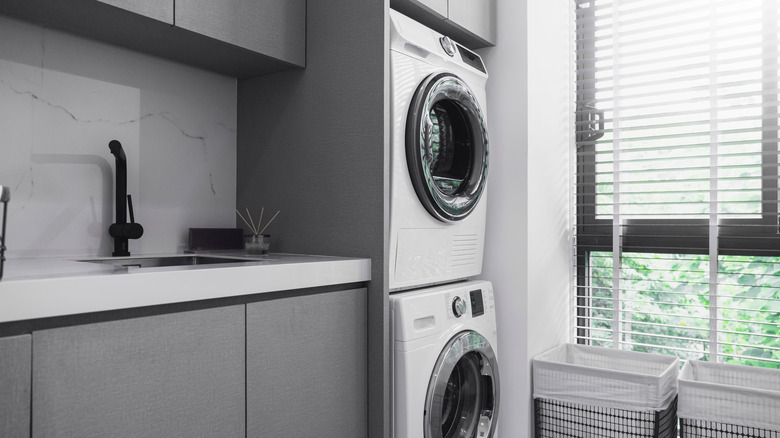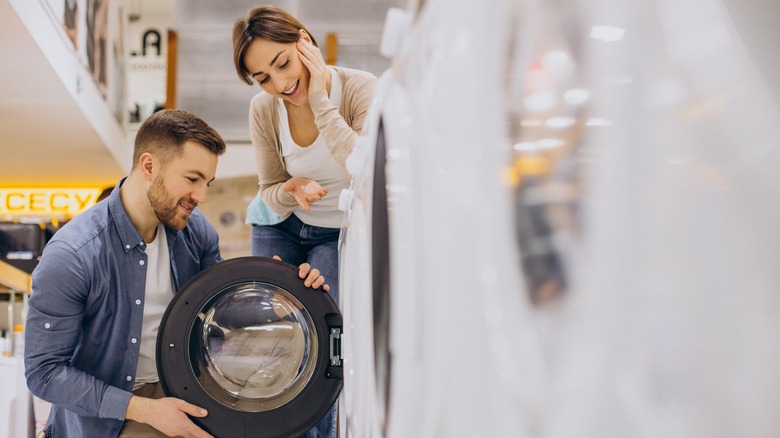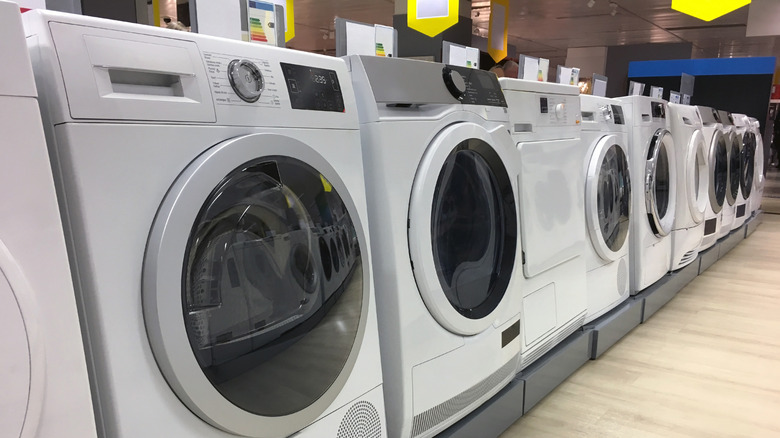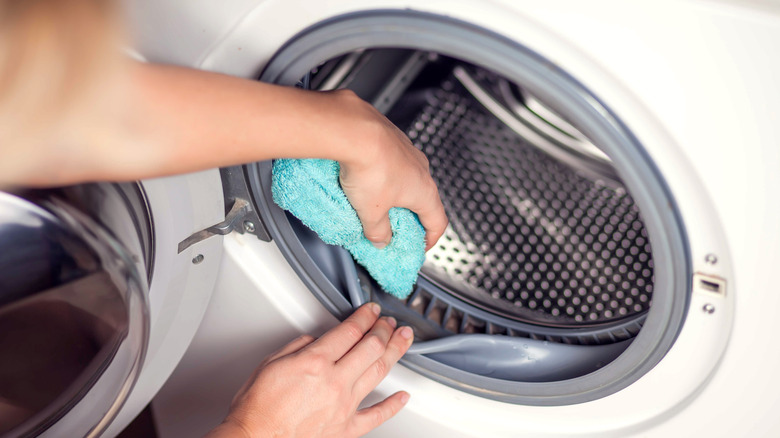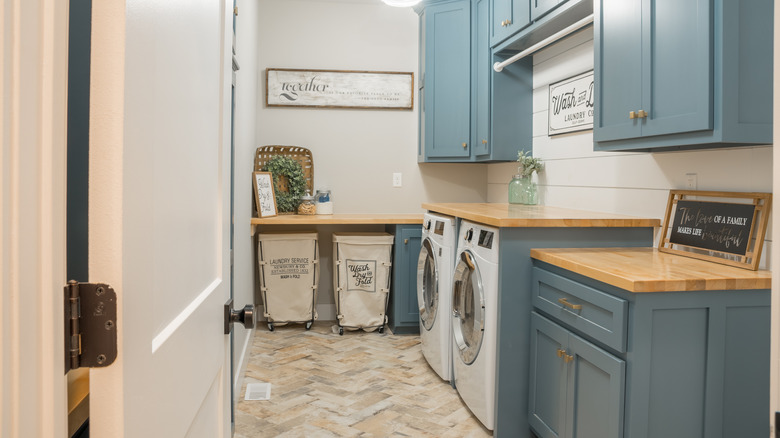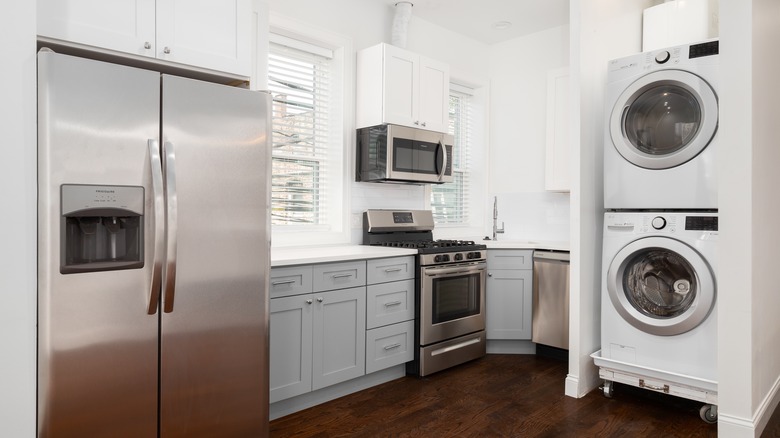The Hidden Downsides To Stackable Washer And Dryers
Doing laundry can seem like an endless chore. Delightfully scented detergents, cute hampers, and folding fresh fluffy clothes can make the task a little more enjoyable. But nothing impacts your laundering experience like the washer and dryer you choose. With the wide range of available options on the market and different setups, your selection of laundry appliance options is endless.
When shopping for a new washer and dryer, the first decision you'll likely need to make is choosing between stackable units or side-by-side ones. Of course, you'll have features like capacity, power source, and color to consider. However, narrowing your search to the type of units you want is an ideal first step. Plus, each type has its own unique set of benefits — and downfalls.
Side-by-side units are the classic option that many buyers are used to. However, many are tempted by the benefits that stackable units offer. As Apartment Ratings points out, a stackable washer and dryer set saves space. This gives you more room to navigate your laundry area and store supplies. They also allow you to utilize the vertical space in your laundry room. Yet buyers should keep in mind that these pros don't come without a set of cons as well. These are some major downsides you should consider before splurging on stackable laundry appliances.
What is a stackable washer and dryer set?
A stackable washer and dryer set consists of separate washer and dryer units. The washer is heavier than the drier, especially when full, as per Designer Appliances. It can also vibrate and shift more when operating, thanks to the spinning of wet clothing. For these reasons, the washer is always the bottom part of the arrangement, creating a solid foundation.
Stackable washers and dryers come in both full-size and compact sizes. Full-size units are about 27 inches wide, while compact ones are about 24 inches wide. Compact stackable units don't need an exterior vent, making them ideal for apartment dwellers.
A stackable setup has a smaller footprint and allows you to save floor space in your laundry area. However, the units are both independent and fully functional when placed side by side as well. Because of the shorter height, many users opt for pedestals when using stackable units in a side-by-side setup (via The Home Depot). These raise the washer and dryer to a more accessible height and can provide storage drawers underneath.
You're limited to one brand
There are tons of various brands of washers and dryers on the market. Maybe you have one that you love and are loyal to. Or, you might be open to new products and willing to lean on the experience of others. However, when doing your research, you'll likely find that the best brand of washers doesn't always get the same rave reviews for their dryers. There also might be some key washer features from a different brand than a dryer you love.
One major downside to a stackable washer and dryer set is the inability to mix brands. According to Upgraded Home, it's a wise practice to avoid stacking a washer and dryer from two different brands. Units by one brand are engineered to fit perfectly atop each other for the safest, most secure set-up.
Another big reason for using one brand is the need for a stacking kit. These keep units securely attached and prevent movement caused by vibration when in use. The manufacturer makes the stacking kits to the exact specification of their washers and dryers. Not only does this give you another reason to commit to one brand, but it is an added expense as well.
They're more expensive than other options
Purchasing a new washer and dryer set is a significant investment. According to Oh So Spotless, a new washer will cost you from $450 to $3,500 to purchase, while new dryers range from $390 to $3,000. However, the average price for each of these units is about $700, making the combination a total of $1,400.
When weighing your options, you'll likely notice a difference in price points. When opting for a stackable setup, you're only choice is a front load washer. Keep in mind that this will cost about $300 more than going with a top-load option.
This is another time when the inability to mix brands comes into play (via Universal Appliance and Kitchen Center). Your purchase might be unplanned and not budgeted for. With a side-by-side setup, you can easily replace just the washer or dryer. You won't have to worry about the brands matching, so you can choose to only pay for one unit. However, if one part of a stackable setup fails, your options are to splurge on replacing both units or choosing from the manufacturer's current compatible options.
They can also be more expensive to install
Once you purchase your washer and dryer, they'll need to be correctly installed. There is a stark comparison between the installation process depending on your chosen setup. In fact, stackable washer and dryer installation can require multiple people and costly professional help. As wikiHow points out, hooking up a side-by-side washer and dryer can be a quick and easy DIY task. You only need simple tools, and the process can be done by one person. To install the dryer, ensure that the vent is securely attached to the machine and the wall, and plug it into an outlet. For washer installation, you'll need to hook up the water supply and drain hose before plugging it in.
On the other hand, installing stackable units can be much more complicated. A stackable dryer can weigh 150 to 200 pounds, making getting it on top of the washer cumbersome and unsafe (via Build.com). This can't be done alone and requires multiple people and equipment like lifting straps.
This makes it a good idea to have your stackable washer and dryer professionally installed. However, this comes with a price. The national average for washer and dryer installation ranges from $850 to $2,500 (via Fixr). And this number can climb to around $4,000 for high-tech units with top-of-the-line features.
They are tougher to keep cleaned and maintained
According to Consumer Reports, 15% of front-load users had mold or mildew build-up in their washers. This is over 10% higher than top load washing machine owners. It's recommended to keep your front load washer door open to prevent mold, which can be inconvenient and in the way. Top loaders can be kept closed as they don't seal and harbor mold (via LifeSavvy). Plus, their design also makes leaving them open more convenient as the door opens upward and out of the way.
It's also extremely important to clean stackable units regularly and thoroughly. Keeping up with the recommended monthly cleanings can be another big downside (via Dan Marc Appliances). The dryer should be checked frequently to ensure moisture isn't transferring from the washer below. You'll also need to remember to run a vinegar and borax cycle through the washer ever so often to deter mold build-up.
Neglecting to keep one unit clean can cause mold and mildew to spread between both units. You'll have to wipe down the inside well and clean the tough-to-reach creases. The height of the dryer off the ground can cause an additional challenge, and you might need a stool when cleaning it.
Stackable units can be inconvenient for certain people
One of the most significant limitations of stackable units is the inconvenient height. This can make it difficult and even impossible for some users to reach. Maytag reports that a full-size stackable washer and dryer is usually around 77 to 80 inches. With the average woman measuring just 64 inches, easily reaching inside the dryer can be a tough task for many users (via Cleveland Clinic).
Stackable washers and dryers are also not ADA-compliant (via GE Appliances). These guidelines require that controls be within 48 inches of the ground. This is something to keep in mind if you or someone you know uses a wheelchair or has physical limitations.
If you have young children, stackable units might not be a great option. Tragic deaths have been linked to toddlers being trapped inside front-load washing machines (via Consumer Reports). For this reason, keeping the washer door shut is recommended if you have young kids. A childproof lock or a unit with a lock-out feature are also options. However, these can be a recipe for mold and add an additional step to remember.
Even if you have older children, stacked units can be inconvenient. Most children between 10 and 12 are ready to do laundry with help (via Hippo). And many 13-year-olds can be responsible for their laundering. However, most of these tweens and teens aren't at their full adult height. So, being unable to reach into a stacked dryer and retrieve their clothes can put a damper on their laundering independence.
Stackable units limit your laundry room layout
Sure, stackable units can save you floor space. However, they can also dictate the way you layout your laundry room. As Andrea Zaff of Boston-based Zaff Architecture tells Remodelista, "While dryer doors are often reversible, most front-loading washer doors are left-hinged and can't be reversed ... there are a small number of right-hinged and reversible front-loading washers available."
This can be extremely inconvenient if your plumbing is set up so your washer and dryer are on the left side of a small laundry room doorway. Keeping the front loading washer's door open will likely block traffic and overlap with the doorway. If your laundry door swings in, it might make it impossible to keep your door open at all. If your units aren't stacked, you can likely shift the washer away from the doorway or flip-flop the washer and dryer.
Counter space for folding laundry and storing supplies is helpful in a dedicated laundry space. Having side-by-side units allows you to create additional space to work on. If you have a front-loading washer and dryer, you can build a simple counter over it and hang cabinets, shelves, or a drying rack above (via Sengerson). Even if you have a top-loading washer, you can still work with the space above the dryer for shelving and hanging clothes to dry.
Is it worth it to buy a stackable washer and dryer?
Stackable washers and dryers are attractive options for many homeowners primarily due to their space-saving designs, and they're usually more energy efficient than comparably priced top-load units. However, Consumer Reports notes that the purchase of front loading washers necessary for a stackable setup dipped from 38% in 2009 to 28% in 2020. Instead, 72% of those purchased in 2020 were top loaders.
There are some key reasons for these changing trends. Users specifically note that they were resistant to purchasing front loaders due to mold, maintenance, and odor issues. They also might be finding better values with top loaders. Senior market analyst Mark Allwood says, "The higher price of front-loaders might have made them think twice."
If you purchase from a reputable brand, you can expect your stackable washer and dryer to last 13 to 15 years (via How to Fix It). So you're likely to see plenty of usage for your investment. However, only you can decide if the trade-offs for saving space are worth it. After all, you'll likely be living with your new laundering setup for years to come.
